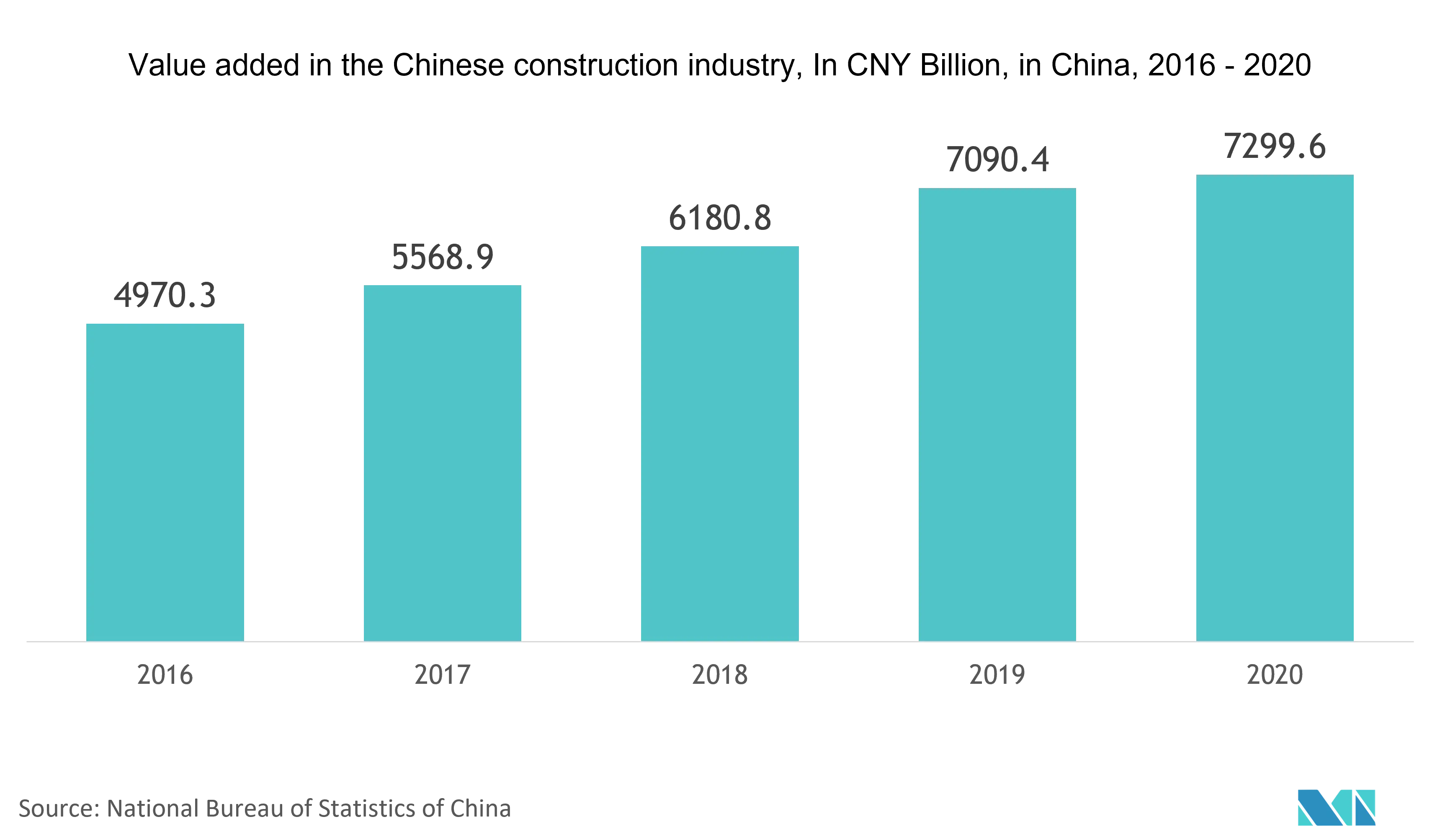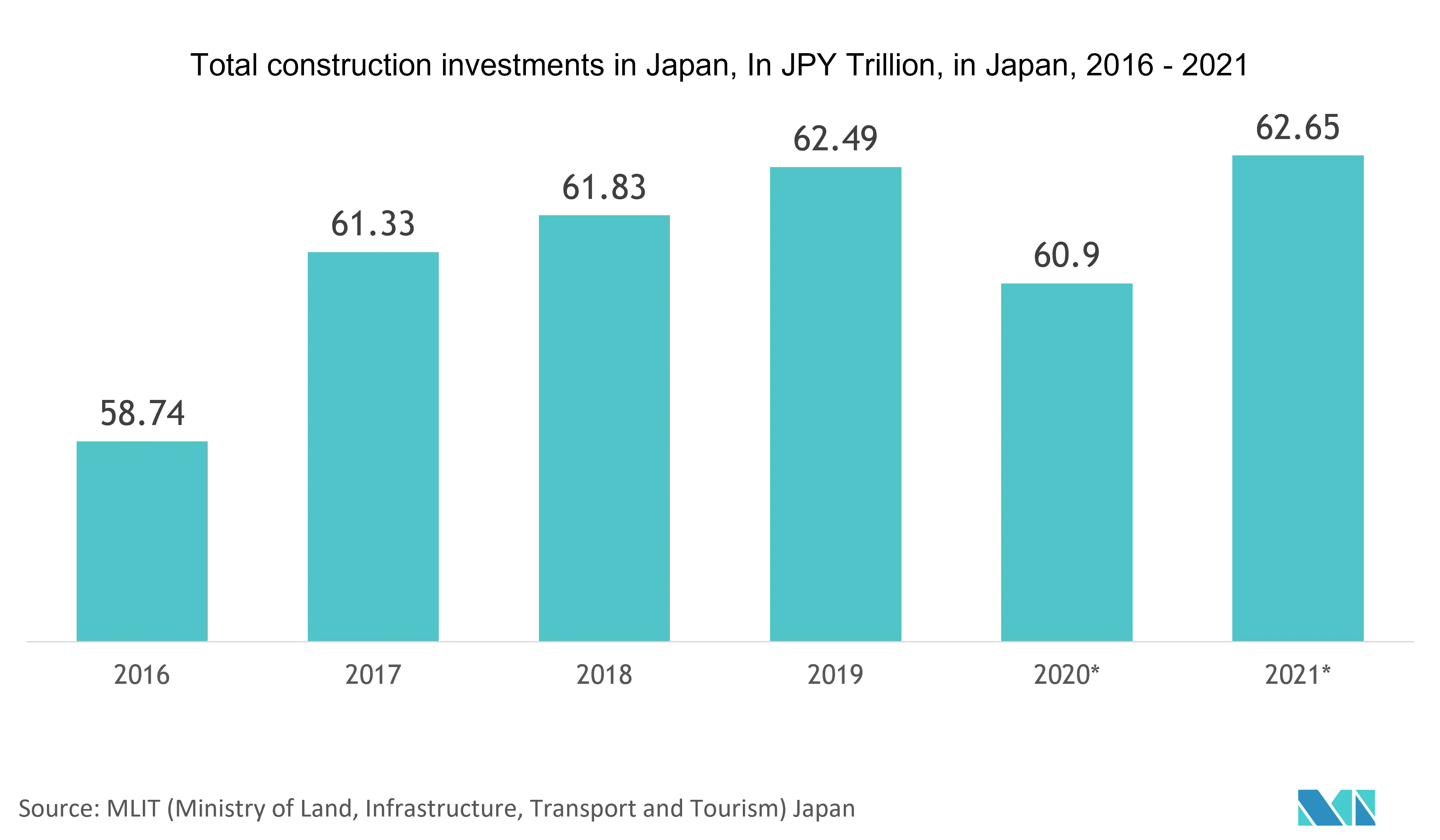Market Trends of APAC Smart Glass Industry
This section covers the major market trends shaping the APAC Smart Glass Market according to our research experts:
Construction industry is expected to have further growth opportunities in the market
Smarter construction processes and methods are influencing the construction industry in the region. As per the National Bureau of Statistics of China, it is projected that the construction revenue in China will amount to approximately USD 3.812 billion by 2024. China has become one of the largest construction markets in the world. In 2020, the construction industry value in the China region amounted to USD 1,049 billion U.S. dollars. As the government has planned to focus on improving the infrastructure in small and medium-sized cities, the construction industry is expected to maintain a continuous growth at around 5% annually, as per the National Bureau of Statistics of China.
Various initiatives for clean technology, energy conservation, and sustainable use of energy are driving the customers to use different products, which would serve their purpose. The region is considered to be the fastest-growing economic region, with countries such as China and India developing at a rapid rate. Also, the emerging economies, such as Malaysia, Singapore, and others, are experiencing growth in their industrial, construction, and infrastructural sectors. This economic development has created a need for enhanced infrastructure; thus, the construction of malls, hospitals, and other buildings is growing at a high pace. The growing construction sector in these countries is expected to influence the smart glass market.
In Singapore, buildings are the second largest energy consumers, using almost a third of the electricity. Most of the modern building facades are often as much as 80% glass, which makes them less compatible with the sustainability and energy efficiency goals, as mandated by the government, to cope with urbanization and climate change. Thus, installing smart-tinting windows can reduce a building’s energy consumption by 20%, on average, as compared to conventional glass, thus, reducing the load on the heating, ventilation, and air-conditioning systems.
Also, increasing urbanization and commitments to conserve resources and reduce greenhouse gas emissions will further create a scope for the adoption of smart glass in the region. Countries, such as China, made significant progress in developing national green building standards. In recent years, The Ministry of Housing and Urban-Rural Development of China set clear goals to achieve the development of green buildings by 2020, in the 13th Five Year Plan for Building Energy Efficiency and Green Building Development. The Chinese government has mandated green building in government projects and has also used market-based instruments (like subsidies and public procurement) to promote green building.
Similarly, Korea Green Building Council also recognizes that the deployment of green buildings is one of the essential factors in the construction sector, with an aim to build sustainable and eco-friendly cities. This is impacting the adoption of smart glass in the region.

Japan region witnesses significant growth opportunities in the market
Smart glass is primarily used in the region to improve passenger experience in the transportation sector. For instance, AGC’s light control glass, using Research Frontiers’ SPD-SmartGlass, is installed in one of the trains of the Japan Railway Construction, Transport, and Technology Agency. This window glass, mounted in the train, combines a thin, chemically-strengthened glass with SPD-SmartGlass, to reduce weight by 30% and improve passenger comfort.
There have been increasing applications in the field of transportation that are creating immense demand for smart glass in the region. Smart glass has found a large-scale application, particularly in the automotive industry, in sunroofs, and exterior and interior automatic dimming rear-view mirrors. In fact, as most of the smart glass products are chemically toughened, they are far lighter than the traditional glass used in the automotive sector when installed in automobiles, helping automakers gain more fuel efficiency and meet regional emission standards.
According to METI (Ministry of Economy, Trade, and Industry) Japan, In 2020, approximately 8.07 million motor vehicles were produced in Japan, which is slightly down from about 9.68 million units in the previous year. The decrease was primarily due to the production halt during the Covid-19 pandemic. The production volume of motor vehicles in Japan included passenger cars, trucks, and buses, of which passenger cars accounted for the majority.
Smart glass is also increasingly being adopted in the construction sector in the region. According to the Ministry of Finance Japan, the construction industry in Japan generated sales of approximately JPY 133.9 trillion in 2020. In 2020, total construction investment in Japan was estimated at around JPY 60.9 trillion, with building construction accounting for almost 50% of these investments, forecasted to increase to JPY 62.7 trillion in 2021, according to the Ministry of Land, Infrastructure, Transport, and Tourism, Japan.
Windows are considered the most inefficient part of a building and are responsible for heat loss in cold months and solar heat gain in warm months. Some researchers also stated that sunlight entering a house could increase cooling loads by 20%. In some cases, glare from the sun can make it difficult to see an LCD screen, requiring the blinds to be pulled, negating the benefits of natural light. These are expected to bring further growth opportunities to the market in the region.

